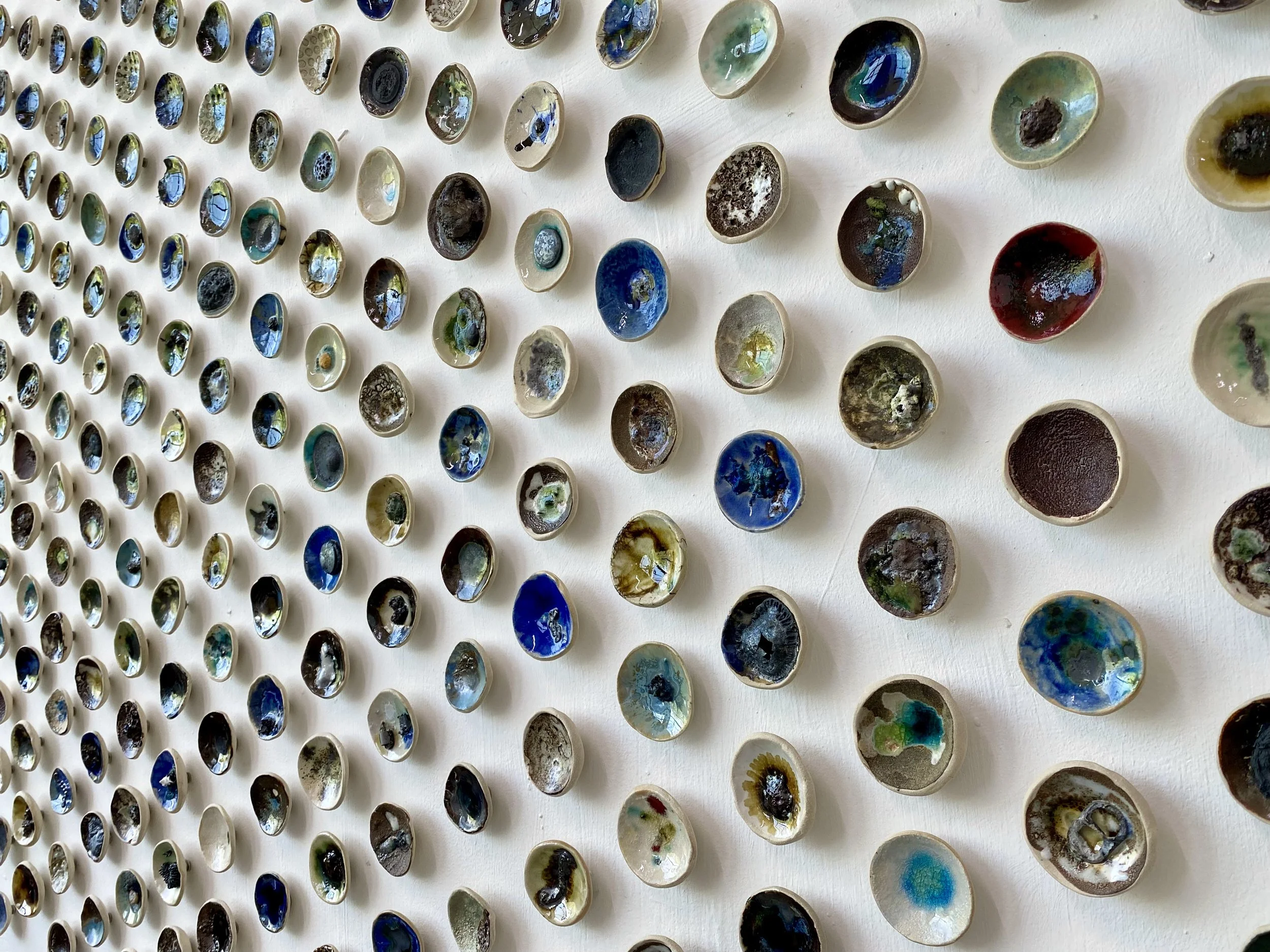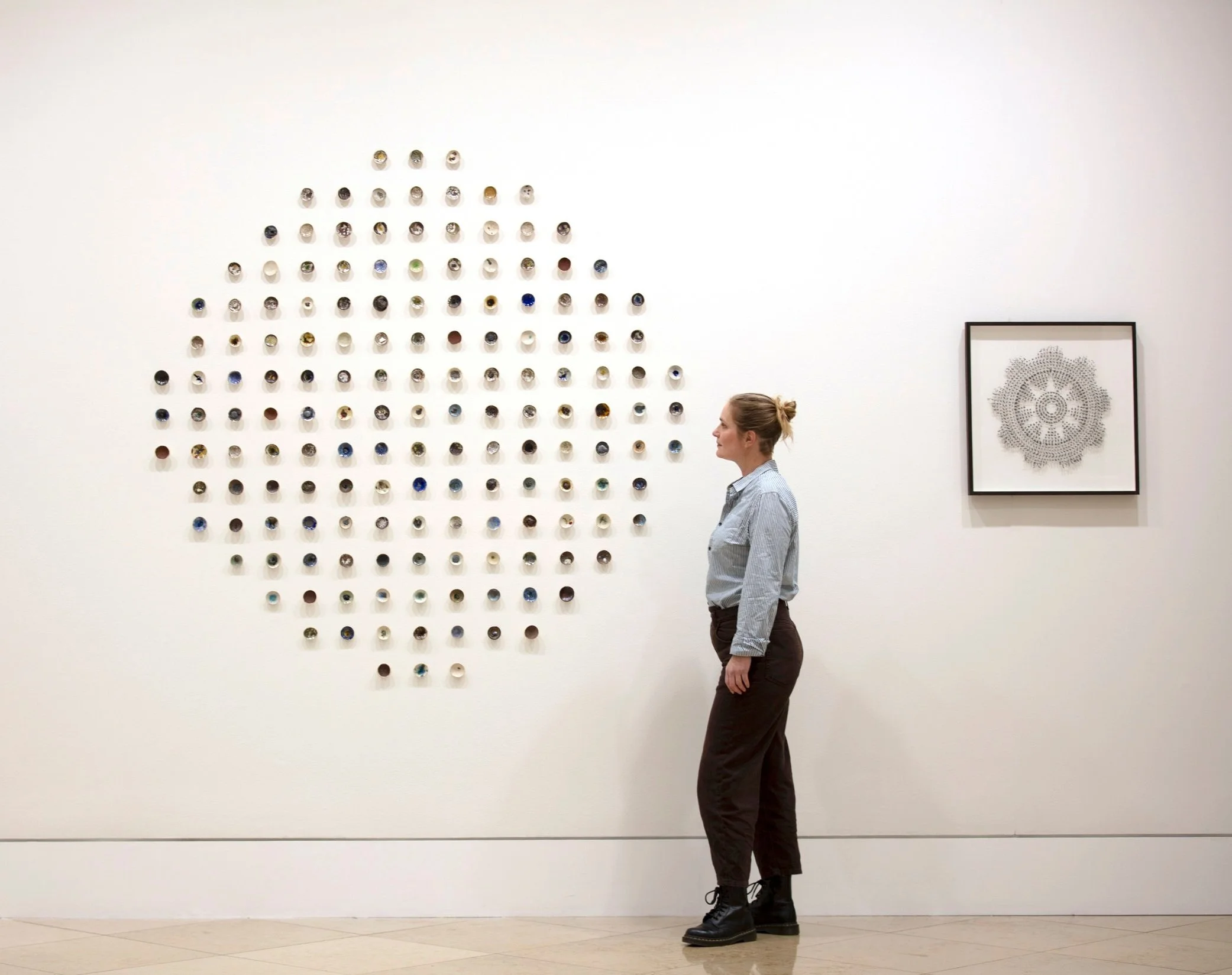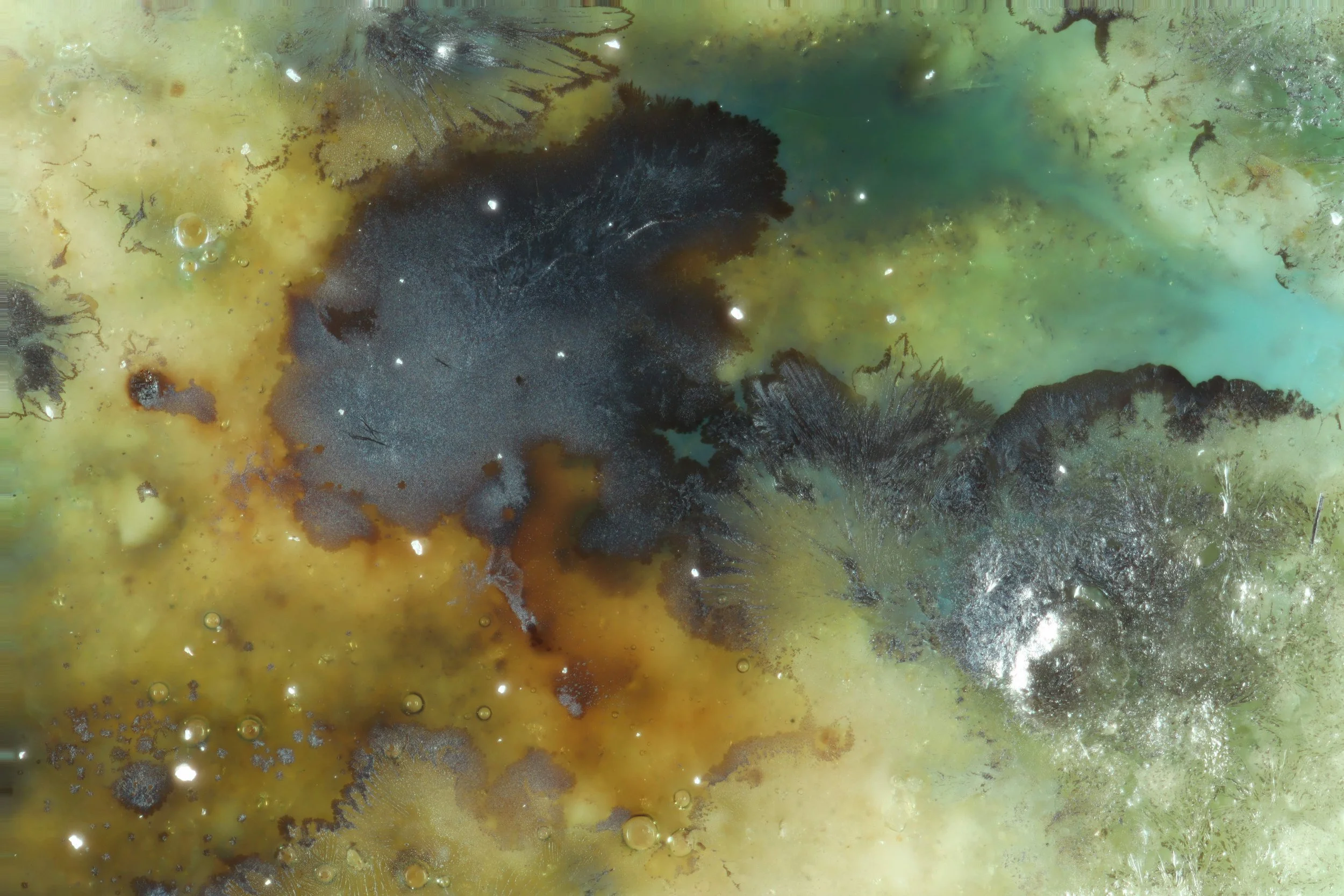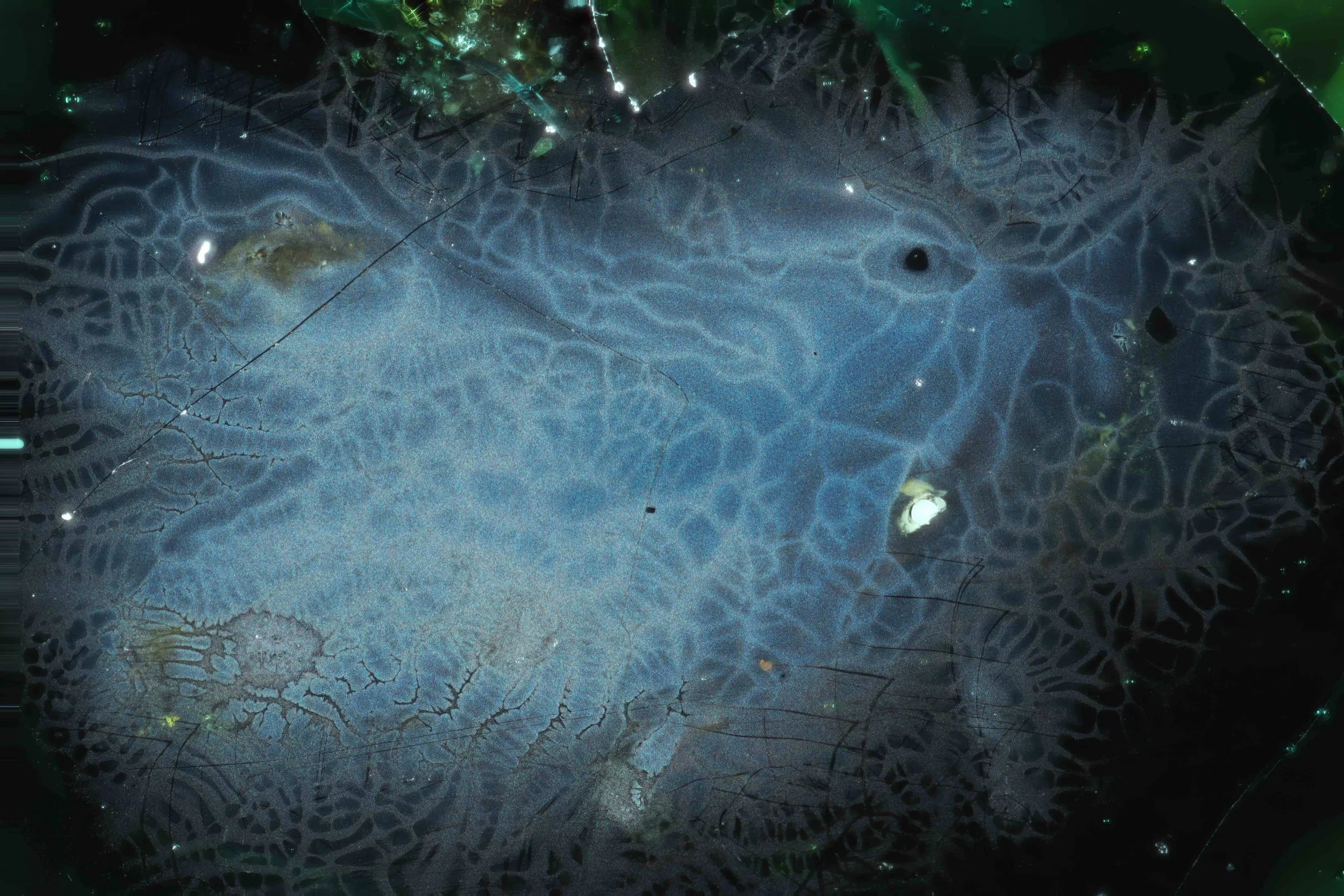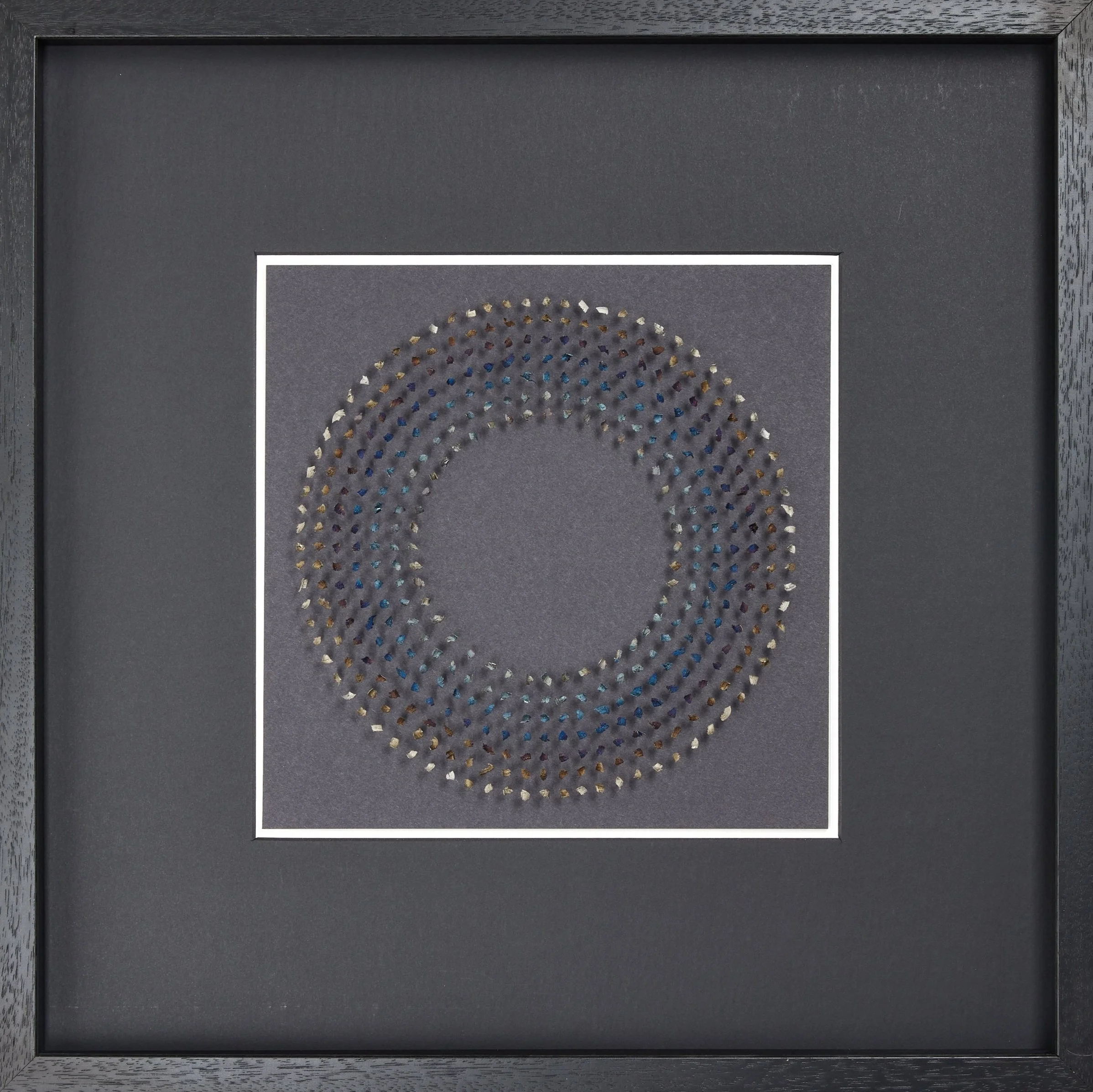Maja Quille portfolio of relevant works
Singularities
Title piece for recent solo show at SAK Gallery, Denmark in 2023. The piece is made up from 2300 steel swarf mounted on pins. The shards are the debris from the installation of an artwork protection system at Tate Gallery London. The wall piece has a kinetic sister piece.
Work in progress - new constellation of Set in Stone
Moments in Time and Set in Stone (2025)
Ceramics, found waste and microscopic images
Continually evolving projects, which came out of my Art council funded project on London Clay (2021-22) and Creative Residency with Museum of London Archaeology (2024-25).
These works were inspired by the concept of technofossils; the geological footprints that humans will leave behind through their material goods. I have been exploring ways of recreating the natural language of the earth through experimental ceramics, making hundreds of small ‘pinch pots’, one of the most fundamental ceramic shapes and an integral part of the ceramicist’s process. Each one of the pots combines waste materials from London, such as dust from the underground and beer bottles found on the street, with different layers of London Geology. I then photograph the hidden universe of the work, invisible to the naked eye, through a magnification lens. In this process, familiar patterns emerge, resembling images from telescopes of nebulas, weather patterns, brain scans, earth's landscape images from satellites. I am fascinated by this iconographic resonance across different areas of life; in cultures, in mathematics and in the natural world, which is repeated within the micro and macro.
Substance of the Wind
Air pollution particles and soap on paper
Series of unique prints, dimensions variable.
This is an experimental series of bubble prints blown with pigment made from London pollution and particulate matter gathered in a facemask in high-traffic areas of South London. The ghosts of bubbles past, the prints are permanent imprints of ephemeral blisters of germs and carbon emissions. Each print is unique and at once beautiful yet repulsive, questioning wonder, value and the legacy of an industrialised world.
Above: London particulate matter on watercolour paper, 45cm x 45cm (framed), unique, 2021
Threshold (2018)
Joint commission by University of Edinburgh and Royal Observatory Edinburgh. Located at in the Higgs Centre for Innovation, Royal Observatory.
Based on research into the Higgs Boson at University of Edinburgh and CERN, Geneva and in close dialogue with High Energy Particle Phycisist Dr Victoria Evans. The project is based on a visualisation of what would happen to particles if the Higgs Boson, which gives mass to particles, was ‘switched off'‘. An impossible object, at once present and absent, the sculpture consists of roughly 16,000 gemstone spheres attached to wires running floor to ceiling. The optical illusion was generated by a bespoke computer program, developed with programmer Peter Balch. The beads, which make up the image of a door, only come into alignment as the viewer walks towards it upon leaving the building (enlightened?). From all other angles it appears as a ghostly cloud, a mist of nuclei drifting in the air, the fundamental part of its mass and energy removed. The door is an elusive object that leads to the unknown possibilities of future scientific endeavour; how will the discovery of the Higgs boson shape the future of science, now the door has closed upon the standard model.
Externalities
This series of cyanotypes sprung out of an interest in the everyday, the overlooked and the unseen. The underlying theme of the works is an inquiry into time and the dichotomy between the fleeting and the permanent. The works explore visual associations and the relationship between sunlight, hydrocarbons, plastics, time and bodies of water. The prints are all based on single-use plastics, exposed by the sun to leave behind a lasting imprint in shades of blue. Every print is unique and the result of a particular moment in time: weather conditions, shadows, the time of day and the time of year it was made.
undercurrents
This series of work is made from discarded steel shards donated by machinists, artists, fabricators, engineers and metal workers. The shards are arranged into geometrical patterns, some of which are generated by a strand of chaos theory maths combining two types of formulas, Sierpinski carpets and Julia sets; one describing symmetries, the other chaotic systems. They are a type of maps or contemporary ‘mandalas’ describing equilibrium, balance, time and the shifting edge between chaos and order. Hand-made from hundreds of steel shards; the result of the same, mechanised action and yet all uniquely different, these discarded pieces are the result of the circumstances of a specific moment in time.
Works above, clockwise from top left:
Discrete System, 90cm x 90cm (framed), 2020. Metal swarf donated by an art student
Tribology, 54cm x 54cm (framed). Metal swarf donated by artists
Absolutism, 55cm x 55xm (framed), 2022. Steel shards donated by a machinist fabricating parts for the energy sector,
Strange Attractor VIII, 75cm x 75cm (Framed), 2020. Metal swarf donated by artists
Strange Attractor IV, 55cm x 55cm (Framed), 2020. Metal swarf donated by artists
Strange Attractor X, 55cm x 55cm (Framed), 2021. Metal swarf donated by artists
Isobel, 45cm x 45cm (framed), 2023, brass swarf from the construction of architect Bjarke Ingels’s houseboat
Julia, 45cm x 45cm (framed), 2023, Steel shards donated by a machinist fabricating parts for the energy sector
Catherine, 45cm x 45cm (framed), 2023, Steel shards donated by a machinist fabricating parts for the energy sector
Fleeting (2019)
Commissioned by Aberdeen City Council as a memorial to the Hazlehead crematorium scandal, which saw the ashes of more than 200 infants lost due to past practices at the crematorium.
The sculpture was developed over several months in close dialogue with the affected parents, who wanted a peaceful and positive memorial, which would provide a safe space for reflection and remembrance. This was a profoundly humbling and rewarding experience and taught me a great deal about working with diverse groups in a sensitive way. Based on a prolonged period of time spent with the parent group in order to understand their vision, this project succeeded in emotionally engaging people who might not normally appreciate public art, drawing together a group of individuals from different backgrounds to create a memorial reflective of their hopes and wishes.



